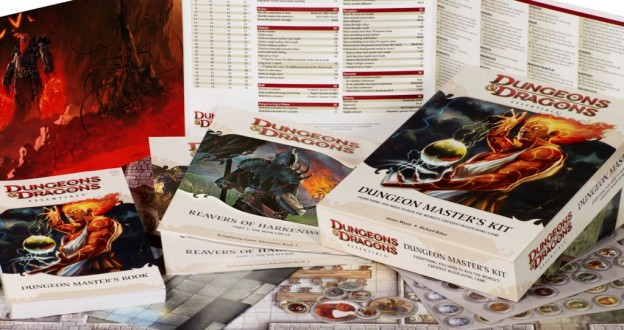I’ve been using the new Essentials Dungeon Master’s Kit for about a week now. Something I was curious about originally (and therefore figured others probably are) is whether it is simply a rehash of the existing 4e Dungeon Master’s Guide or has enough new material for veteran DMs to want to pick it up.
Lets put aside for now the maps, counters, DM screen, and adventure included in the box (although to be honest I was happy getting it for those alone), and focus on comparing the books directly. I’m not approaching this as a review of the ‘Kit – there will be enough of those by now. This will be a true comparison of the two books for those wondering whether it’s worth having both, or who want to decide which to get.
First off, the Dungeon Master’s Book (the title of the book in the Kit – we’ll use “DMB” and “DMG” to differentiate between the two) opens up with an introduction to the game for new DMs, rather than assuming you’ve just finished reading a player-orientated rulebook. It then heads into what appears to be a heavily-edited version of “The Gaming Group” from the DMG. At that point the direct comparisons appear to end, as the DMB then dives directly into how to run the game through encounters, exploration, and turns.
Just as you’re getting used to that however, we run into an almost-verbatim copy of “Table Rules” from the DMG, followed by an only-slightly edited version of “The D&D World” (DMG Chapter 9) and “Fallcrest” (DMG Chapter 11, minus the “Kobold Hall” adventure and – somewhat disappointingly – the character stats). An amalgamated list of deities from the PHB and DMG can be found in this section, too.
“Running the Game” (DMG Chapter 2) follows from this, with the notable omissions of preparation time (quite possibly mentioning a four hour preparation option was putting prospective DMs off!), improvising (initial eek!), and troubleshooting (initial sigh – but keep reading for good news).
The next 1/3 of the book is an abbreviated set of D&D core rules. Obviously you’ll need the Rules Compendium for the comprehensive version, but to be fair it is more than complete enough for beginning players and certainly enough for veterans to have the most-used rules handy. Happily, the aforementioned sections on improvising and troubleshooting have been moved here!
We head next into “Building Adventures” (from DMG Chapter 6, with Encounters text from DMG Chapter 4), and finish off with “Rewards” (DMG Chapter 7 plus what appears to be the Magic Items section from the PHB – something I felt really ought to have been in the DMG in the first place). The new treasure system is included here too (for those still using the DMG, don’t worry, its just another system and theres no need to dump the existing one if you prefer that!)
All in all, I’d still recommend this for veteran DMs simply because the rulebook format is a heck of a lot easier to lug around (obviously not an issue if you always host the game yourself), and for the rules updates. Plus as mentioned earlier the additional material outside of the book is worth the purchase price alone for me.
For new players, it is also worth pointing out the “dollar buy-in” mentioned by James Wyatt in the preview at http://www.wizards.com/dnd/Article.aspx?x=dnd/drfe/20100817– with this product, DMs no longer need to buy a full set of core rules – obviously many will want to anyway in order to play a character too, but to get started you only need this one box, plus the upcoming Monster Vault when you want to go beyond published adventures. The reorganised layout is also far better for new players, I feel.
